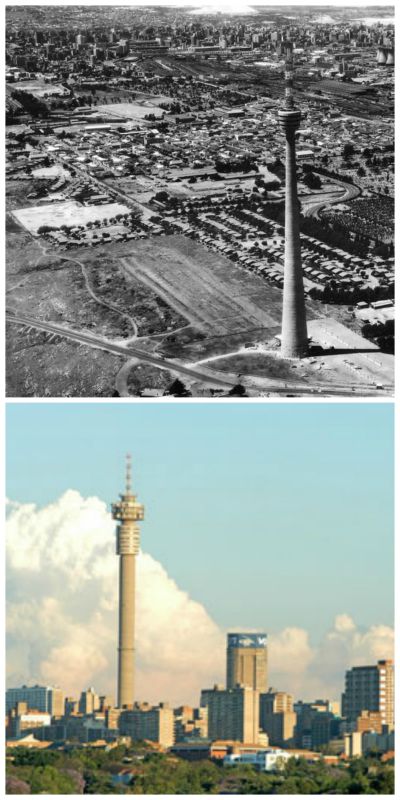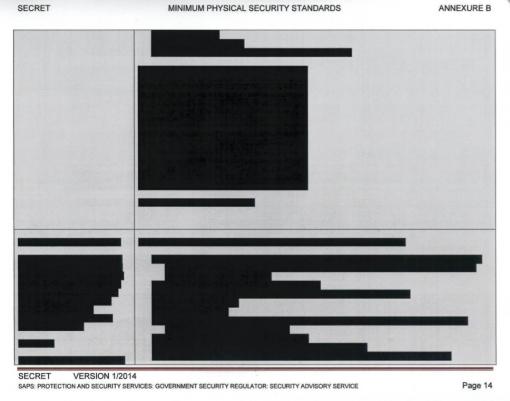The expansive Johannesburg skyline is dominated by two telecommunications towers: the taller, more iconic Hillbrow Tower (also called the Telkom Joburg Tower) in the city and the Sentech Tower to the west in Brixton.

Each tower has its own distinctive aesthetic, but both perform similar broadcasting functions, and both were closed to the public in the early 1980s for fear of sabotage, depriving the public of the breath-taking panoramas offered from their viewing decks.
There is an apparently important, yet intangible difference between the two towers, though - the Sentech Tower is a National Key Point, the Hillbrow Tower is not. This means that the Sentech Tower is afforded additional protection under the National Key Points Act, 1980, the regulations in terms of which place criminal sanctions upon certain actions including the release of “any information relating to the security measures, applicable at or in respect of any National Key Point or in respect of any incident that occurred there.”1
One may well ask why security at the Sentech Tower should be treated any differently to security at the Hillbrow Tower especially seeing as, eleven years ago the situation was reversed - the Hillbrow Tower (then named the JG Strijdom Tower) was classified as a National Key Point, but not the Sentech Tower. Back in 2004, however, there was no sure way of knowing whether or not either building came under the protection of the National Key Points Act, as the list of National Key Points was itself a secret. It was only in January 2015 that the South Africa Police Service (SAPS) finally, when compelled by a court order, released the list of National Key Points to the public following litigation resulting out of a PAIA request made by the South African History Archive (SAHA) on behalf of the Right to Know campaign (R2K).2
The responsibility for oversight of all National Key Points was handed over from the Department of Defence to the SAPS in 2004. Following the release of the National Key Points list in January 2015, SAHA submitted further PAIA requests3 for records regarding National Key Points since the date of handover in 2004. Thus far, a list of National Key Points at the date of handover has been released to SAHA. The 2004 list contained 136 National Key Points, which had increased to 204 by 2015 (an increase of 33%). Some of the names on the list are unsurprising, for example the headquarters and branches of the South African Reserve Bank, and the Koeberg Nuclear Power Station, sites which understandably may require heightened security. Other sites may seem less deserving of special security arrangements, for example the Western Cape residence of FW de Klerk, and the former residences of the late Nelson Mandela in Gauteng, the Eastern Cape and Western Cape.
Some notable additions to the list since 2004 include the South African Mint, City Power Johannesburg, all provincial legislatures, and the Sentech Tower. Other locations have fallen off the list, though, such as Adcock Ingram, the CSIR Satellite Applications Centre and, of course, the Hillbrow Tower. The reasons for these changes are unclear. It is difficult to discern the precise criteria for classifying or declassifying National key Points, as the ministerial powers granted under the National Key Points Act are incredibly broad. A National Key Point may be designated as such if it “appears to the minister at any time that any place or area is so important that its loss, damage, disruption or immobilisation may prejudice the Republic, or whenever he considers it necessary or expedient for the safety of the Republic or in the public interest”. It is therefore very difficult to tell exactly why certain locations are added to or removed from the list of National Key Points, and the case of the Hillbrow and Sentech Towers demonstrates just how arbitrary the classification of National Key Points can be within such an ambiguous statutory framework.
Another major concern is financial accountability under the National Key Points Act. The Act prescribes that the owner of a site declared to be a National Key Point must implement certain security measures at the site at his own expense, failing which public funds must be used to finance the security upgrades and the costs subsequently recovered from the owner. The Act requires a Special Account for the Safeguarding of National Key Points to be established for the purpose of funding these security measures, and into which recovered funds should be paid. The SAPS has informed SAHA that no such account has been established, though, which directly contravenes the Act. Given that the classification of National Key Points carries implications for public funds, it in the public interest to know where the funds for increased security measures at National Key Points have been coming from, and if any expenditure by the state in this regard has been recovered from any private owners. As yet no records on this matter have been made available.
The latest development which could herald improved clarity on the issue of National Key Points and their financing is the Critical Infrastructure Amendment Bill, which is set to arrive in Parliament on the 9th of September 2015. The Bill is a proposed amendment to the National Key Points Act, but it is as yet unknown whether the Bill will promote or stifle transparency. What is known is that the Bill will regulate National Key Points and so called “Strategic Installations”. Whereas National Key Points are mainly private and parastatal entities, Strategic Installations have been described by the SAPS, in response to a PAIA request by SAHA for records relating to declarations and / or declassifications of Strategic Installations, as “National and Provincial Government Departments”. This raises more questions about the classification process, though, as all provincial legislatures are already listed as National Key Points.
SAPS indicated that, though not defined by any legislation, security at Strategic Installations is regulated in terms of the Minimum Physical Security Standards (MPSS). SAHA has also submitted a PAIA request for a copy of the MPSS and records related to the 2014 revision of the MPSS. The decision received from the SAPS on that request was to grant access to the MPSS but, as the review record was still being drafted, access was only granted to the annexures thereto. SAPS's decision noted however that, for reasons of safety and security of individuals and the defence and security of the country, only partial access would be granted to the annexures to both the MPSS and the review record, the version of the annexures released to SAHA was however so heavily redacted as to be an effective refusal.

The secrecy surrounding Strategic Installations raises similar concerns to those raised by National Key Points. It is an ongoing cause for concern that opaque security policies governing undisclosed locations are in place and are as yet inaccessible to the public. Hence, the content of the Critical Infrastructure Bill is eagerly awaited by SAHA in order to assess the extent to which this law will enable or undermine public scrutiny and oversight.






